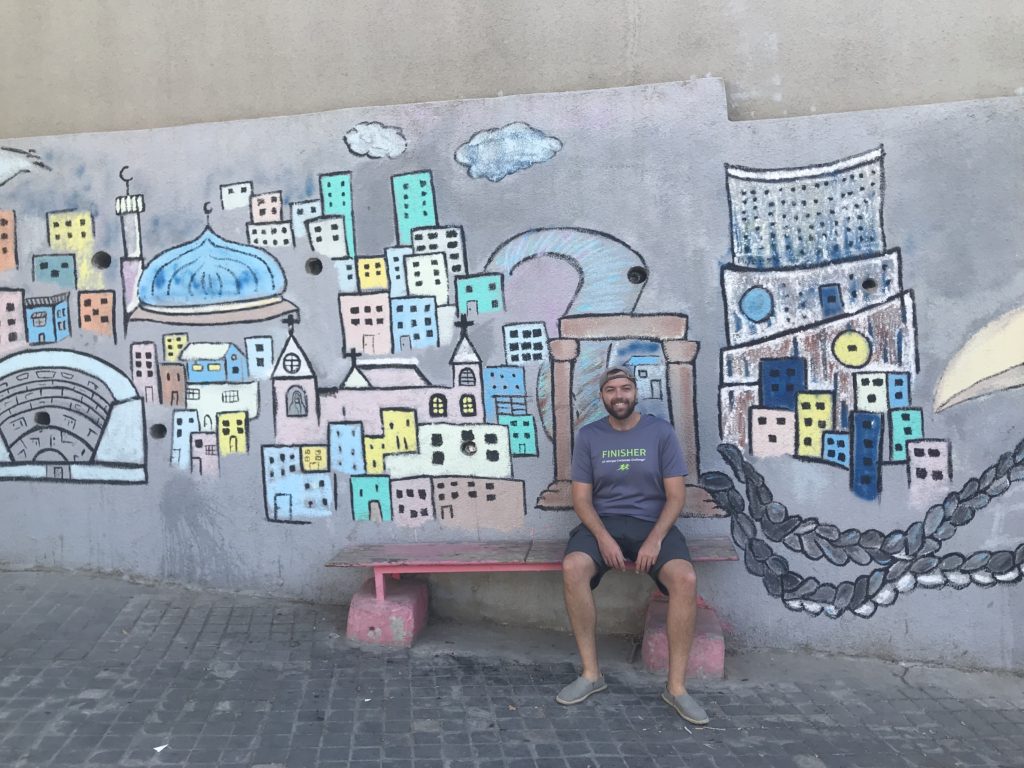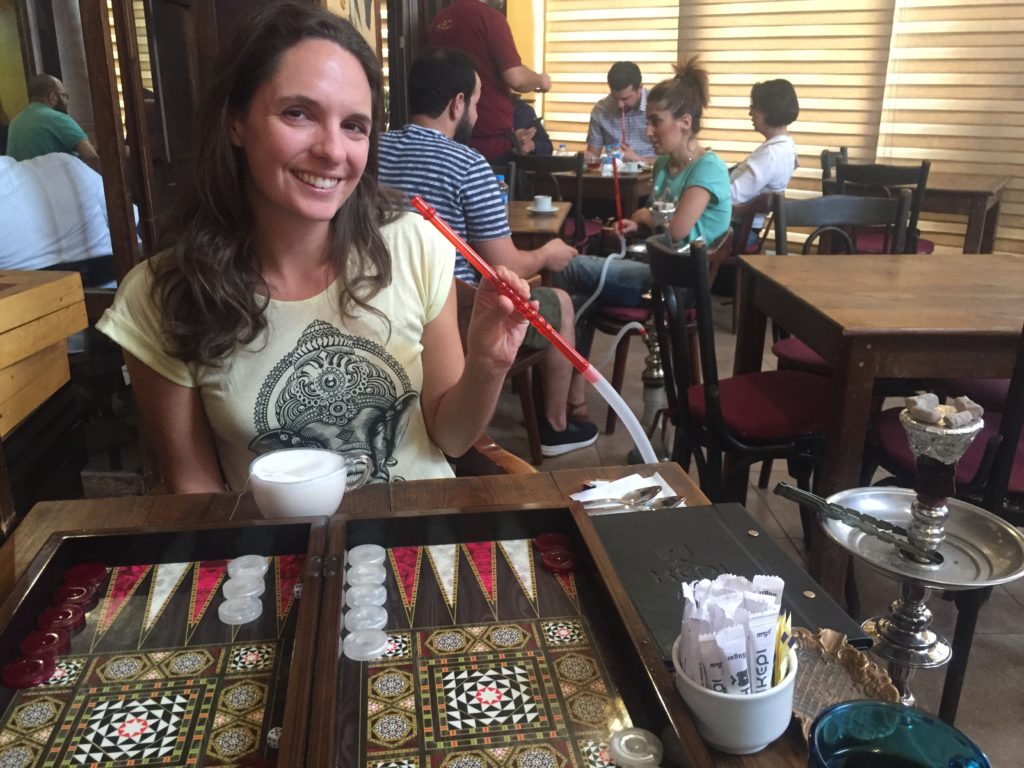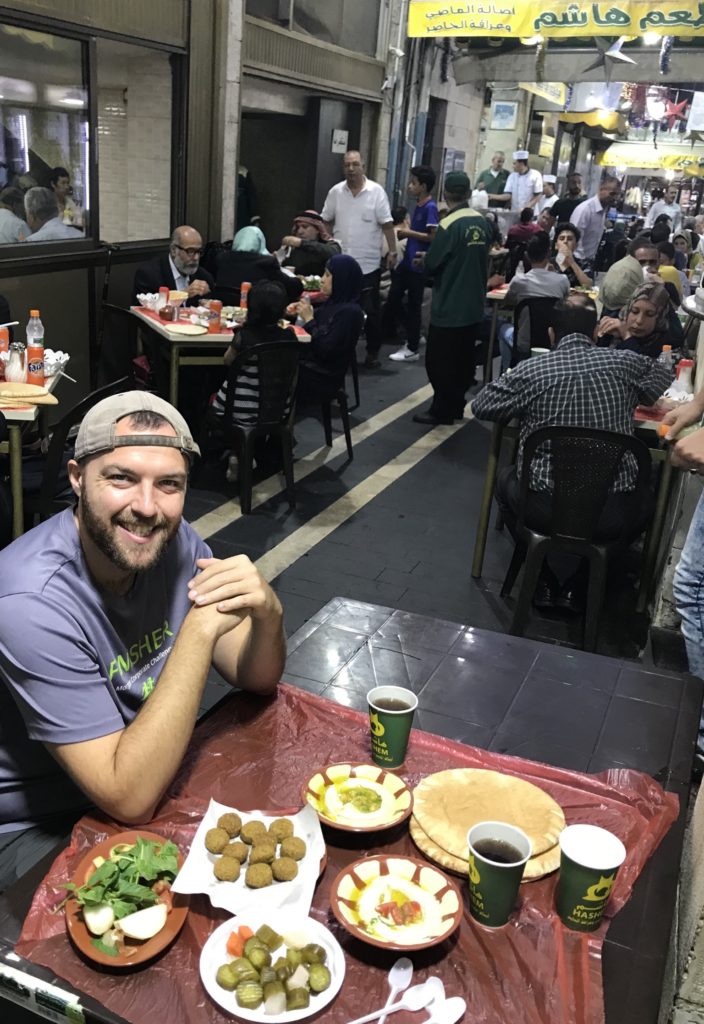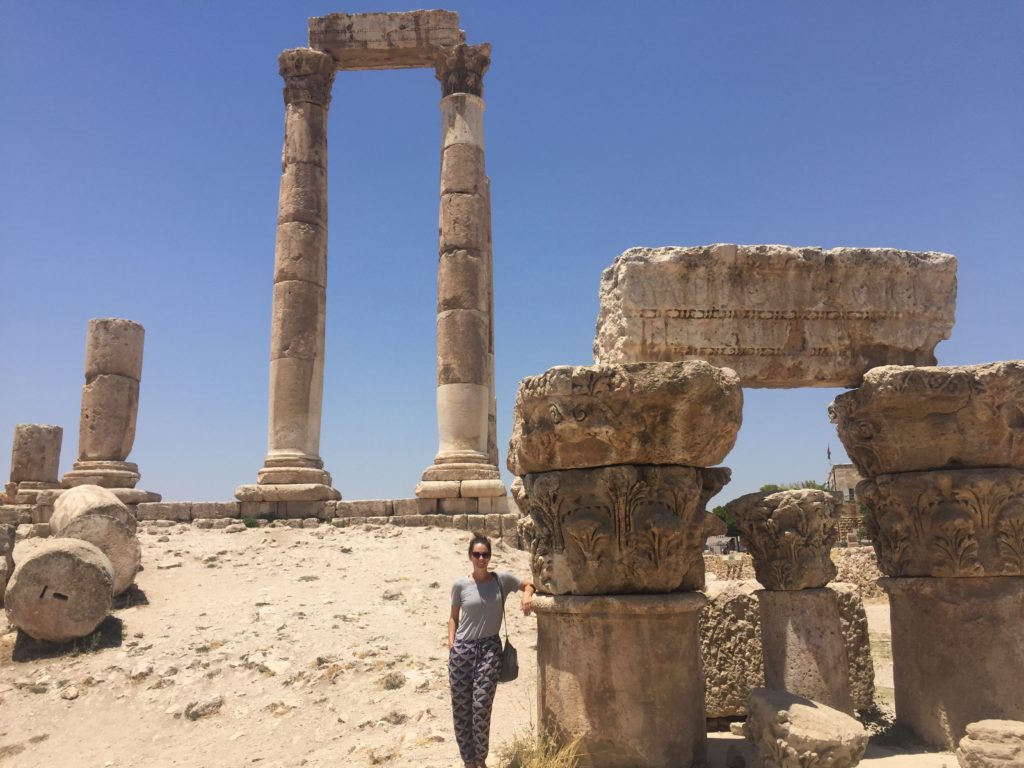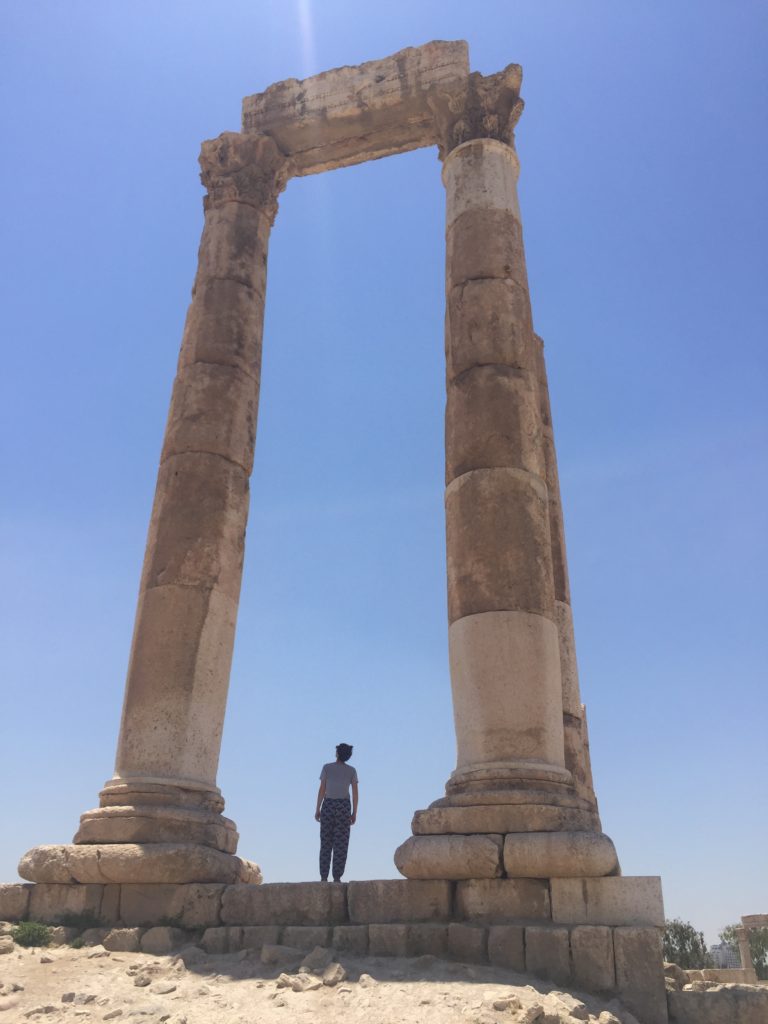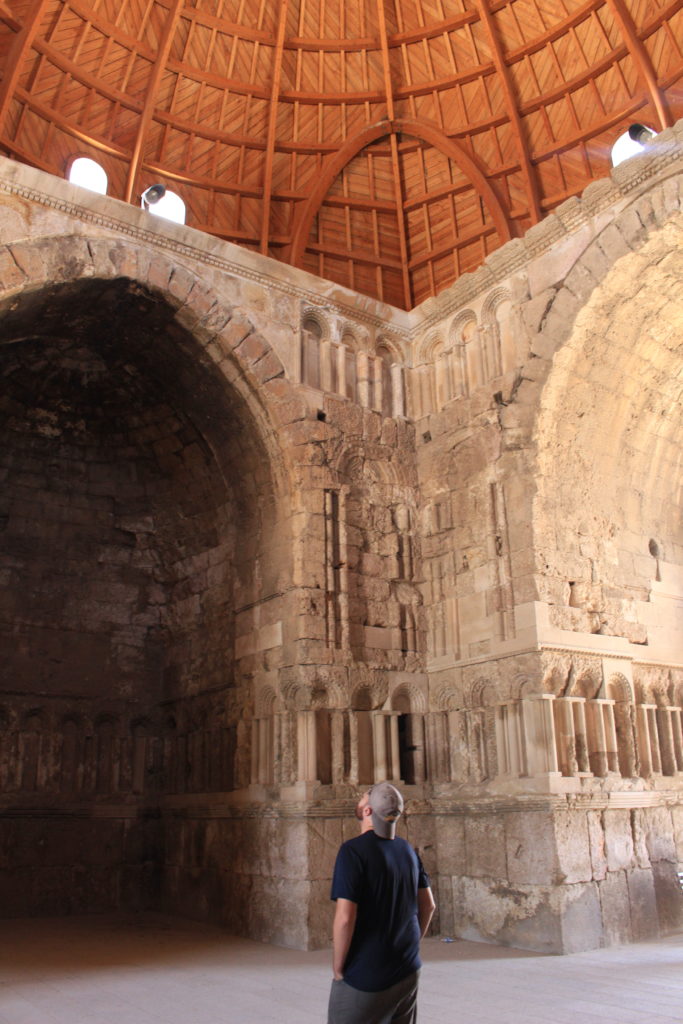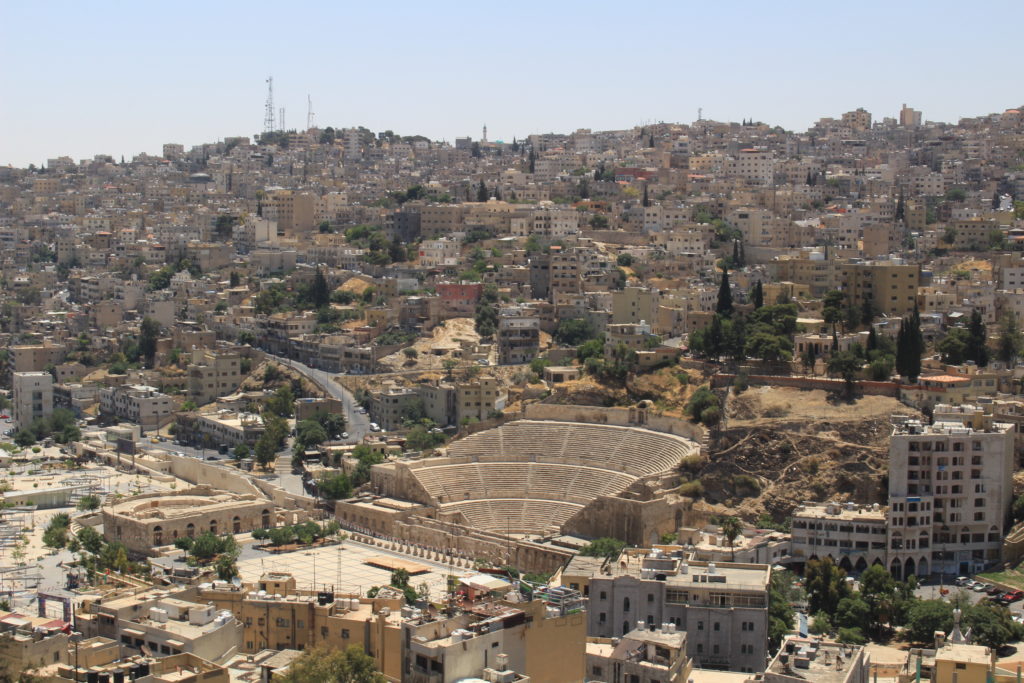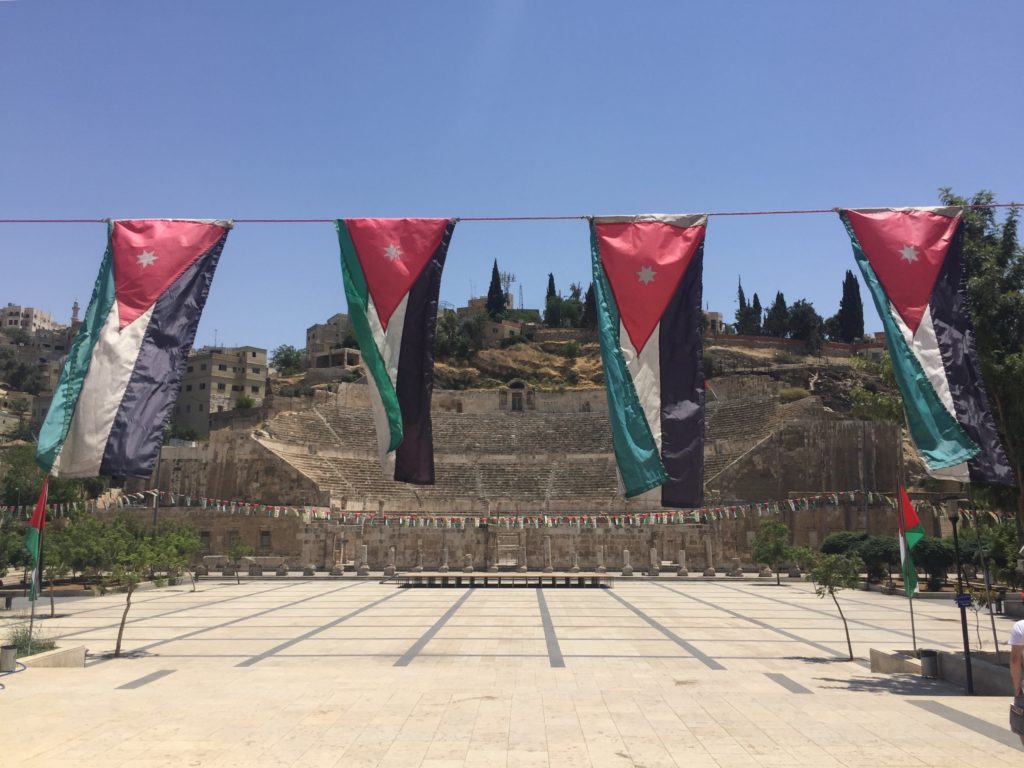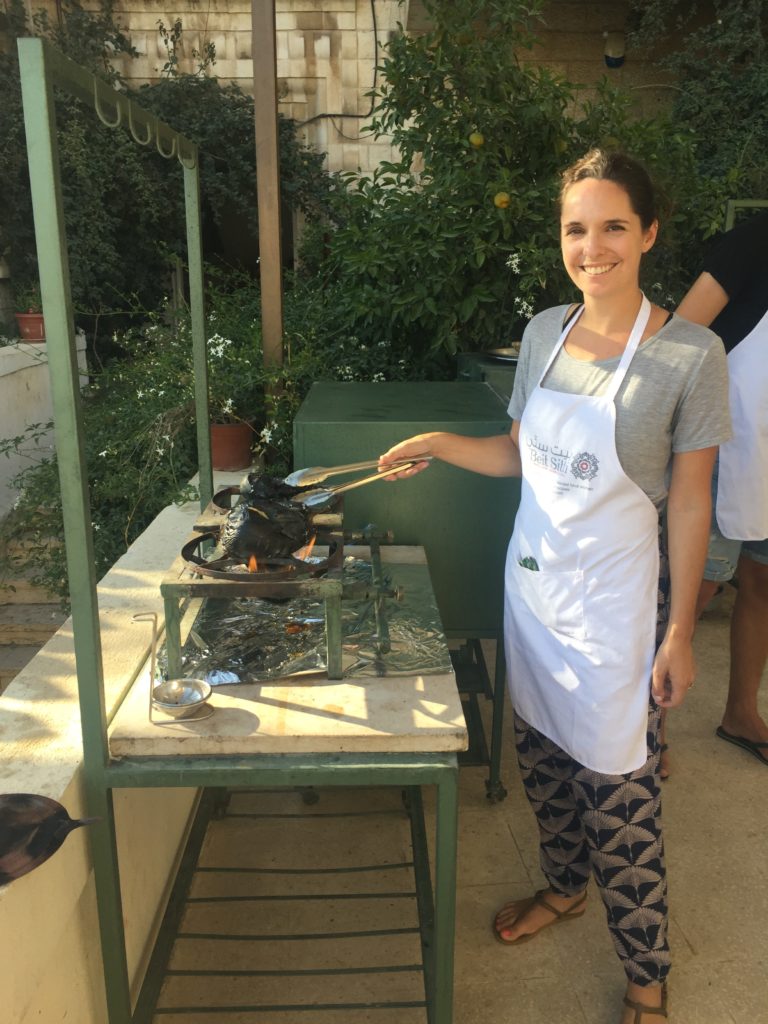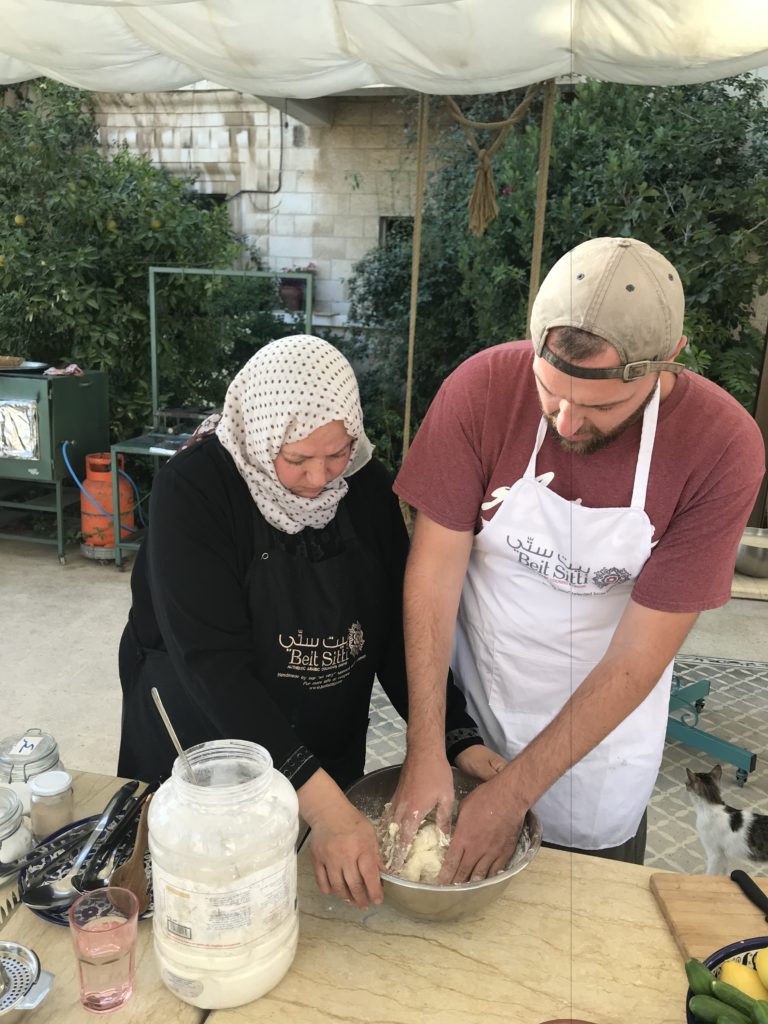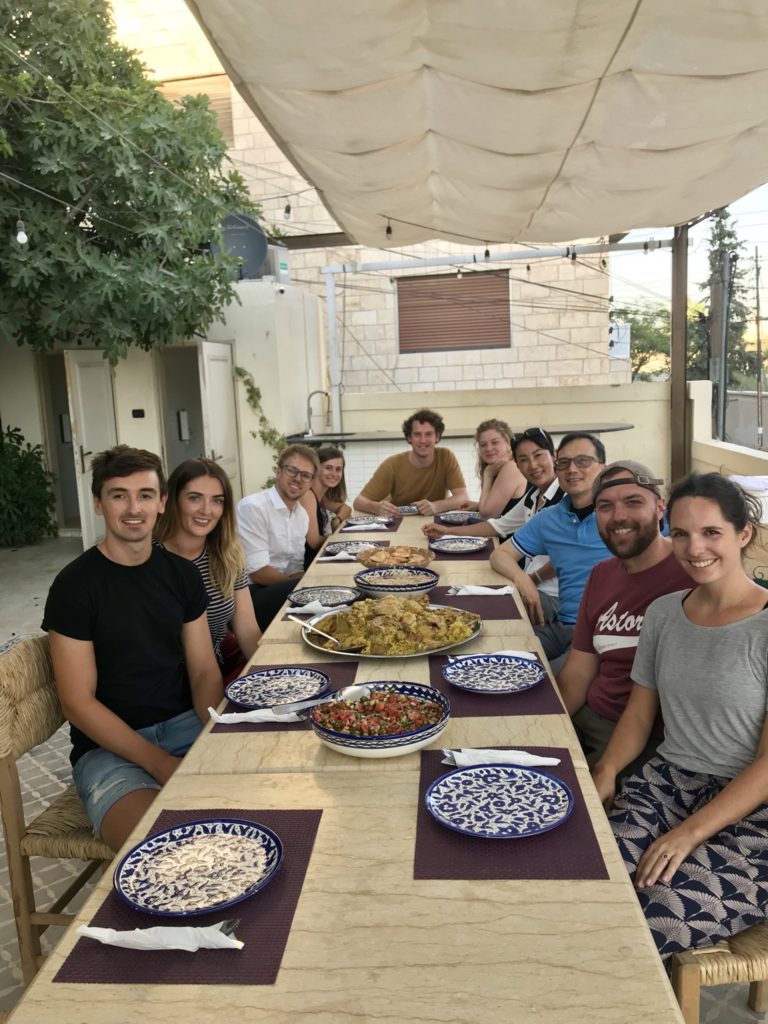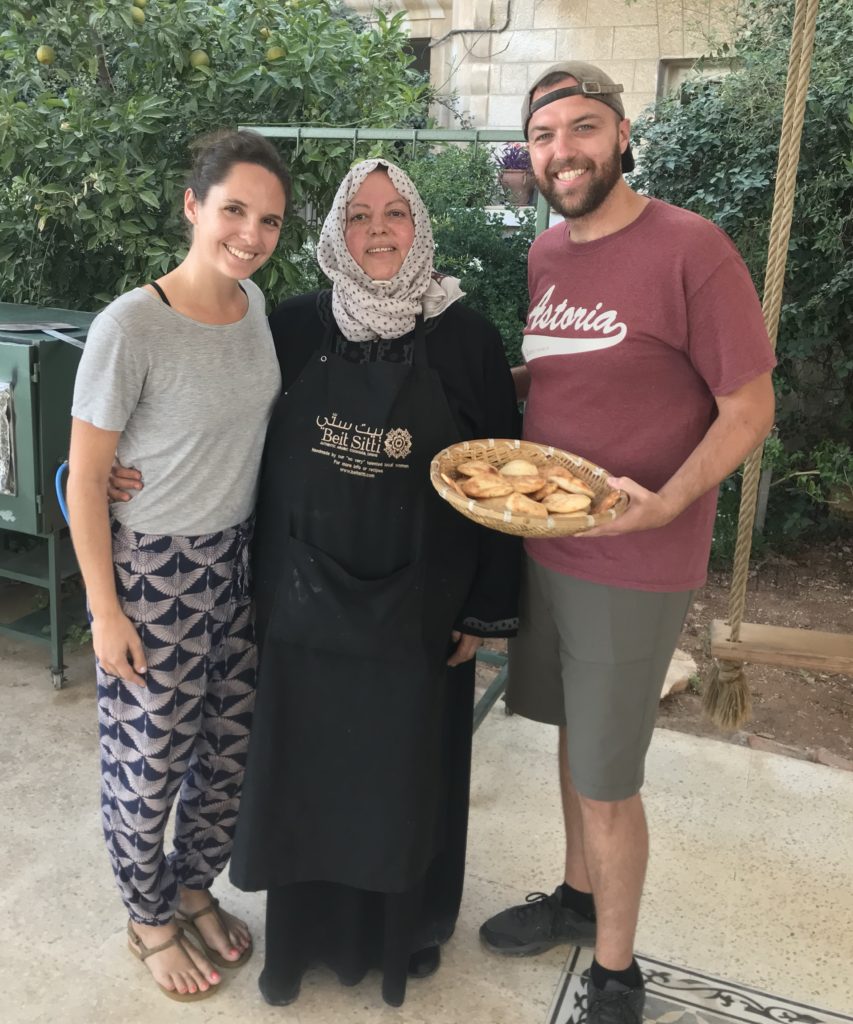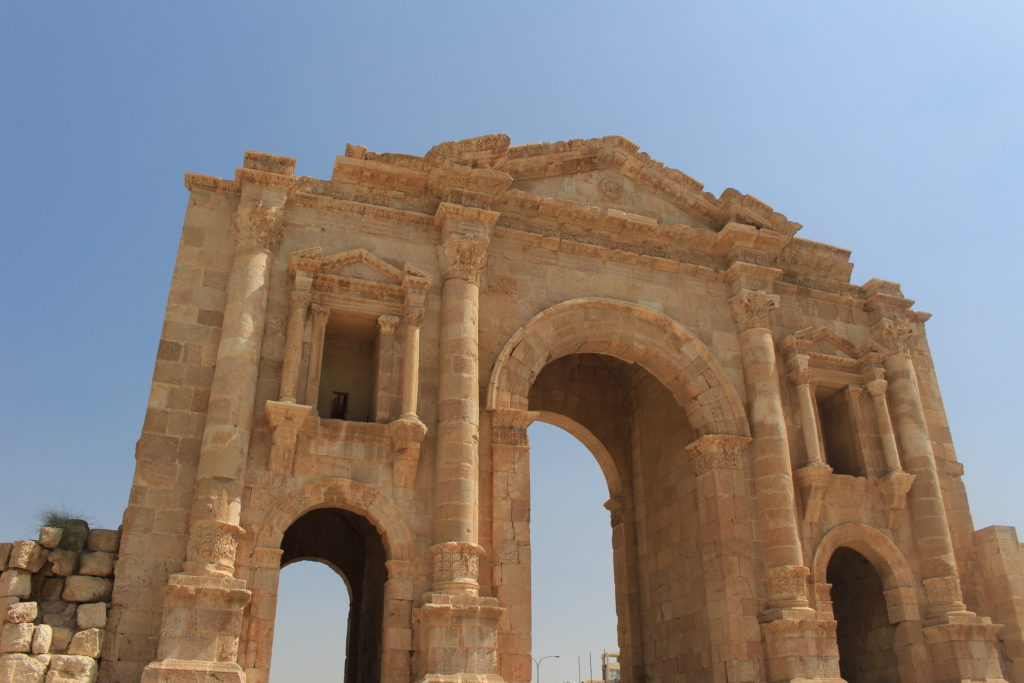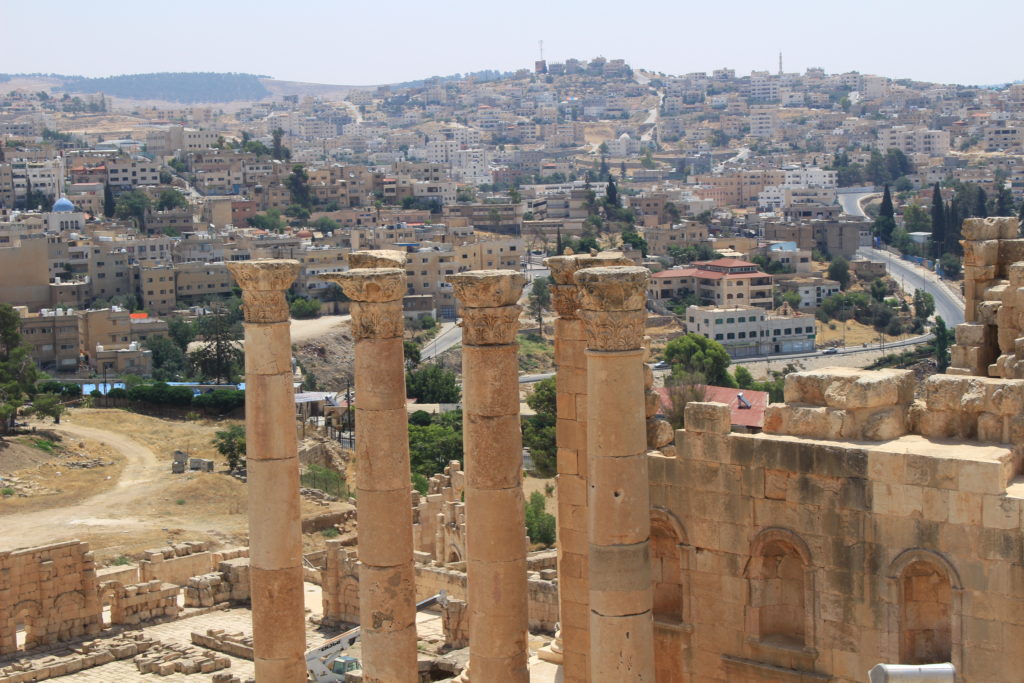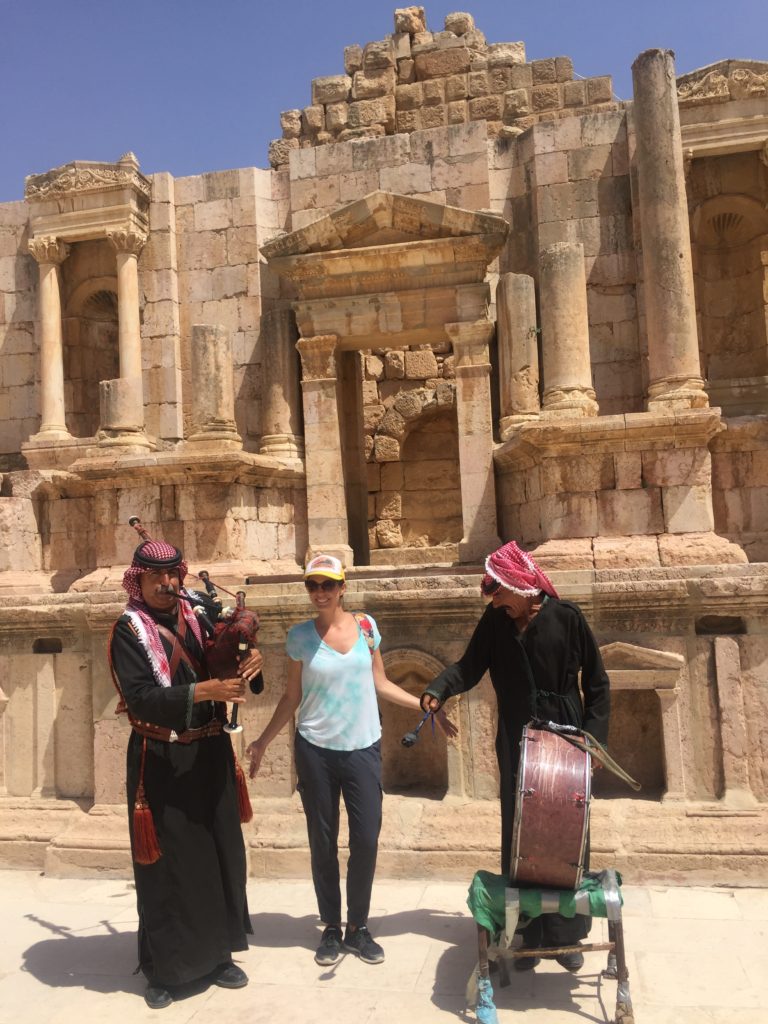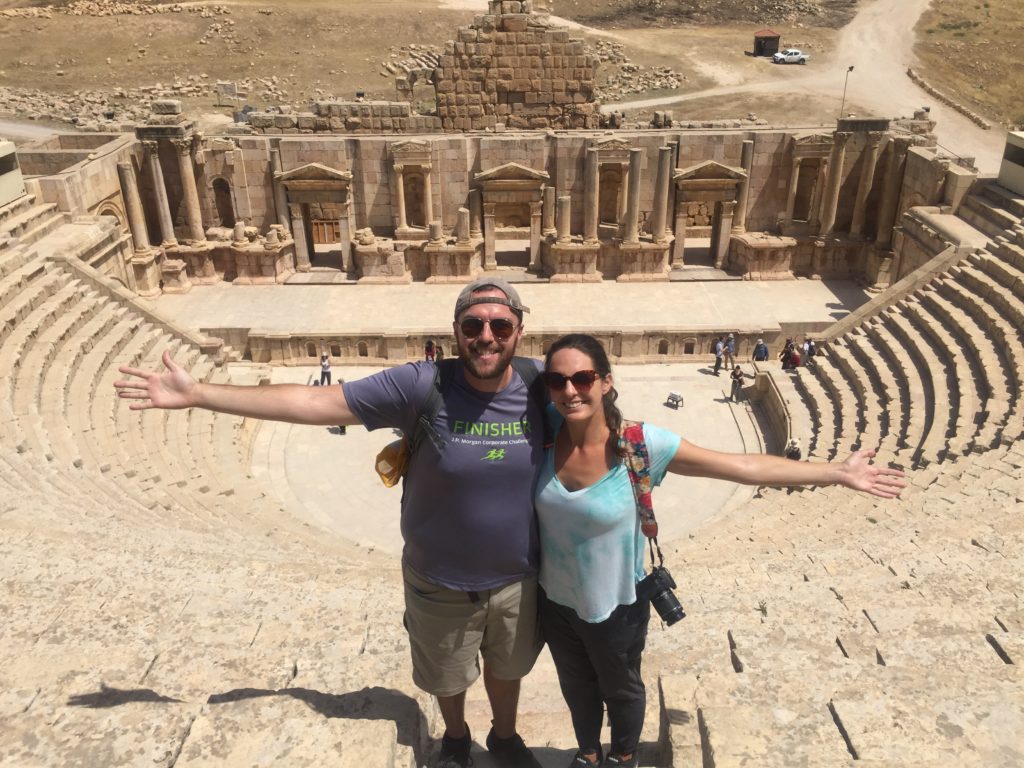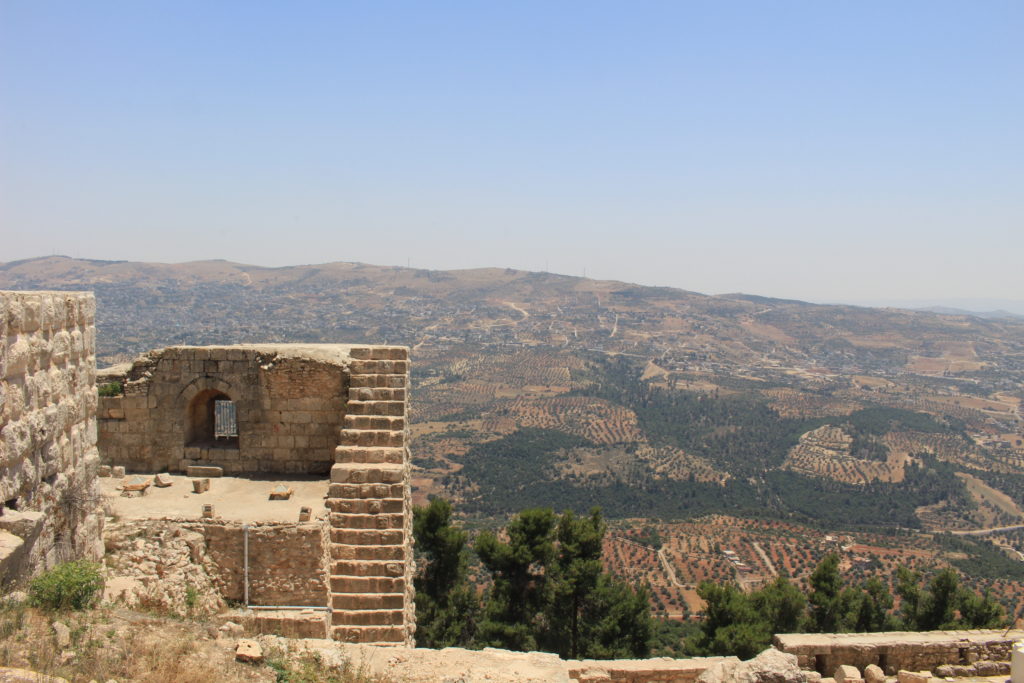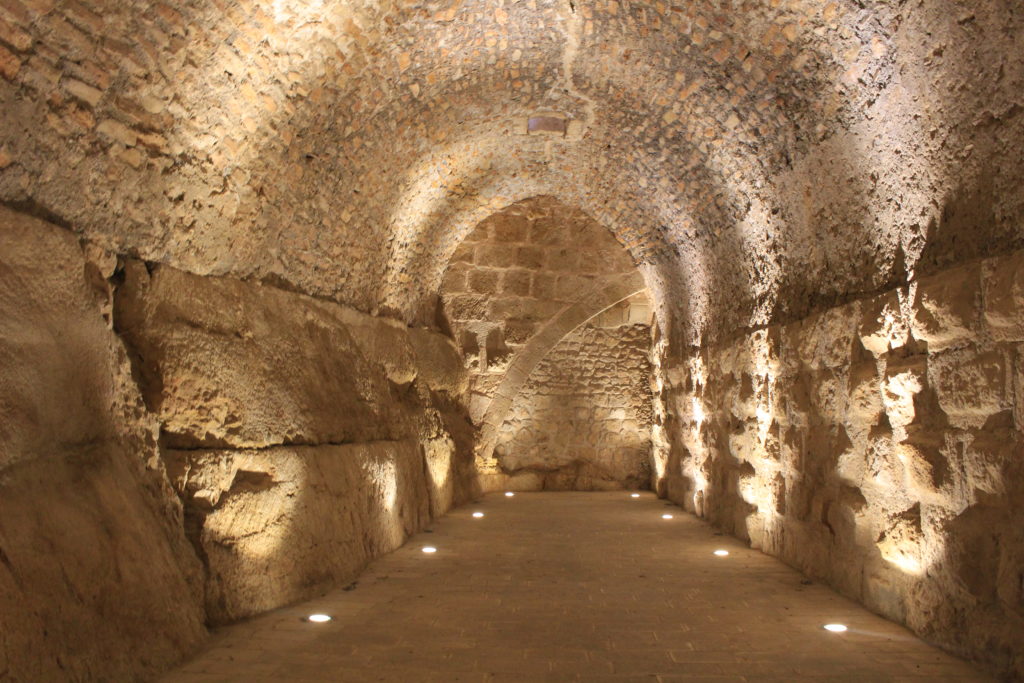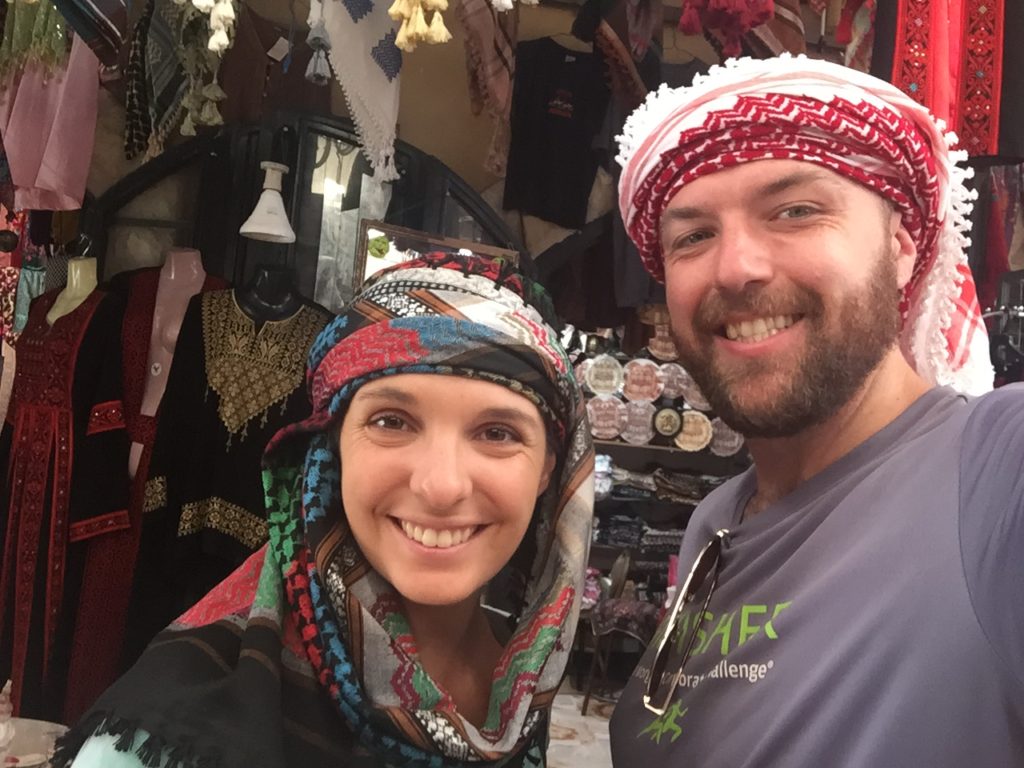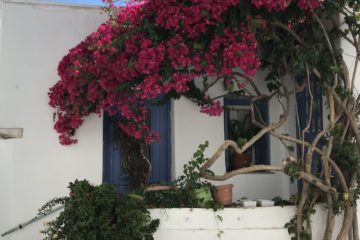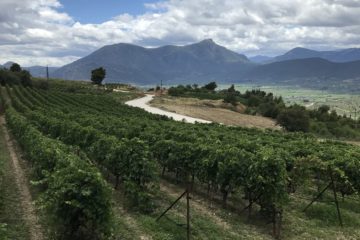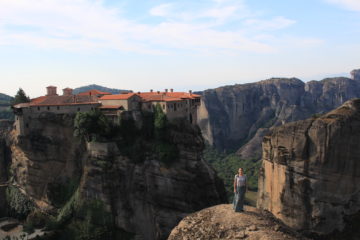After a month of traipsing around the U.S. during our unexpected detour, we finally set out for the next stop in our travels – Jordan – via an overnight flight from NYC (connecting through Ukraine on its national airline, which folks should avoid at all costs). We finally arrived in Amman at the leisurely hour of 12:30am, at which point we had to sort out our rental car and begin the newest wrinkle to our travel efforts: driving. Behind the wheel of our tiny red rental car, we set out for our hotel at a time of day when most of the world is sleeping…but not Amman. It was odd to us at first, but we eventually learned that this is a city where most people sleep until super late in the day and then hangout outside until 2 or 3am (in other words, perhaps Jess is secretly of Jordanian descent?). This meant that the roads were packed with traffic and the cafes were buzzing, making the drive more eventful than expected. Beyond that, several times we turned the corner and found the street packed with automatic weapon-wielding troops, since unbeknownst to us there were massive protests happening in the city. None of this impacted us too much, but it certainly was an eye-opening introduction to the city! [Editor’s note: It’s not clear to me if this timing pattern is due to Ramadan (more on that below!) or in general – but yes, I’m a big fan of waking up late and staying out late. A bustling street scene after dinner and into the night is especially great in a hot city when the nighttime cools you down a bit, too!]
We spent our first few days in Jordan balancing a sincere interest to see the city and its sites against the hellacious bout of jetlag that thoroughly whooped our tails. There was one other item that complicated our efforts – we ended up in Jordan right in the middle of Ramadan. I knew this was the case when we scheduled the trip (I think?), but I thoroughly underestimated its impact (if so). Because the Muslims observing Ramadan (aka basically everyone in Jordan) do not eat, drink or smoke anything between sunrise and sundown, that means most all restaurants and cafes are closed during the day. Further, it is socially unacceptable (but not illegal in any way) and generally just rude to eat or drink in front of Muslims during the daytime during Ramadan, which is what most impacted us. [Editor’s note: The main ways this impacted us were (1) lunch, as in it was basically impossible to get any, and (2) drinking water in the oppressive heat of the day – while no one expected us to be fasting, we tried to respect the locals by not drinking water in public, which led to us cowering in alleyways and corners to surreptitiously sneak sips from our water bottle while out walking around.]
Amusingly, on a day when jetlag = 1, Rorie/Jess = 0, we found a café via Google that was open during Ramadan. When we went to it, all the blinds were drawn and large swaths of paper covered every window. When we peeled back the door, it felt like we were in a real life speakeasy where we could enjoy sins like food consumption and hydration. It was awesome! We ended spending most of the day there, smoking shisha (super cheap and delicious!) and playing backgammon like real (Christian and/or atheist) Jordanians. It was great!
Thus, due to Ramadan, it became an epic struggle for us to get anything to eat during daytime hours. The one cool thing about Ramadan, however, is dinner time when everyone is getting ready to break the day’s fast. Everyone is seated before sunset and restaurants frantically try to serve food to everyone (they don’t want anyone not to be able to eat/drink at sundown), which folks patiently leave untouched on their table. Eventually, when the call to prayer happens everyone in the restaurant begins eating their food at the same exact moment. It’s actually a pretty cool experience that we’ve grown to enjoy (though it doesn’t make up for not being able to eat at all during the day!).
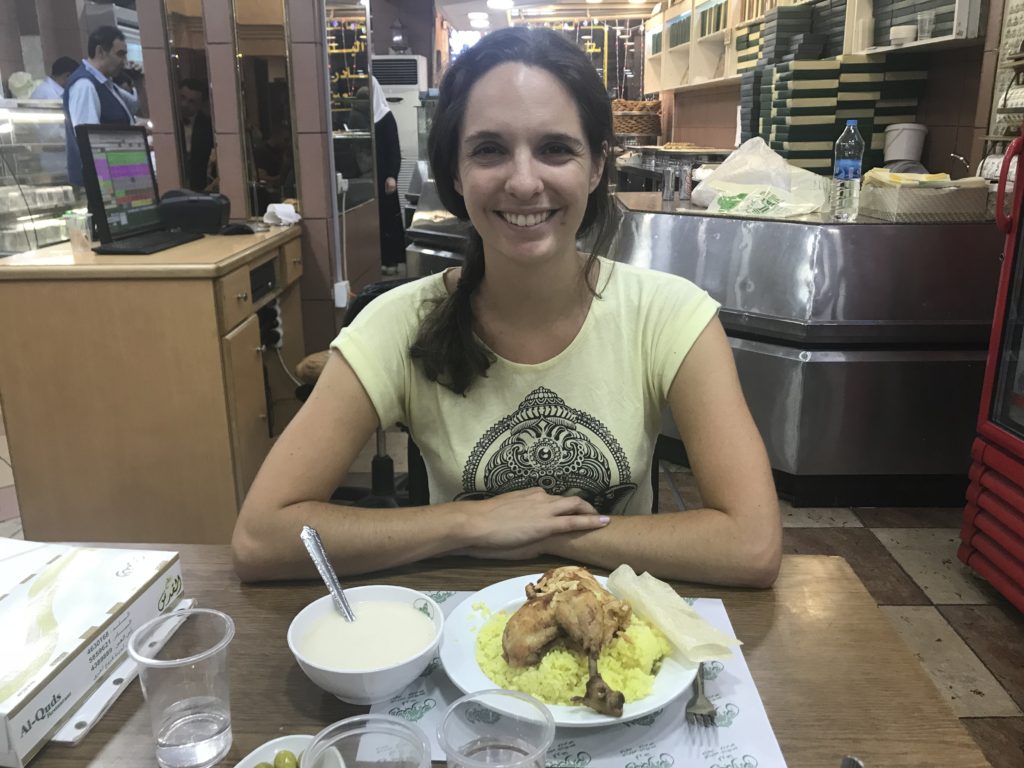
Waiting for sunset with my mansaf, the national dish of Jordan (spoon the yogurt sauce onto the rice to eat).
As for activities in Amman, we managed to squeeze some in during a jam-packed day. Because of the prime location of our hotel, we walked to the Citadel, which is a complex of Roman ruins located in the city. We trudged up the hill (Amman is super hilly, like a desert version of San Francisco) to the Citadel in crippling 100F temperatures, cursing everything about life. Fortunately, we were handsomely rewarded at the site with wonderful views of the city, pretty good ruins and a surprisingly worthwhile museum. [Editor’s note: While we were at The Citadel, one of the daily calls to prayer started in the city around us. Because we had nearly 360-degree panoramas, we began to hear the prayers magnified from mosques all around the city, almost in unison. It was kind of like surround sound, and was a very cool experience.]
From there we were able to walk downhill a few blocks (via some creative stairwell shortcuts Jess learned about online) to the other big site in the city – the Roman Amphitheater. With a capacity of 6000 people, the theater was recently renovated and is now used for occasional concerts and performances. The particularly cool thing about it is the acoustics, with there being one specific point (marked by an etched cross in the ground) where you can stand and speak normally, with everyone in the theater being able to hear you perfectly. It’s amazing!
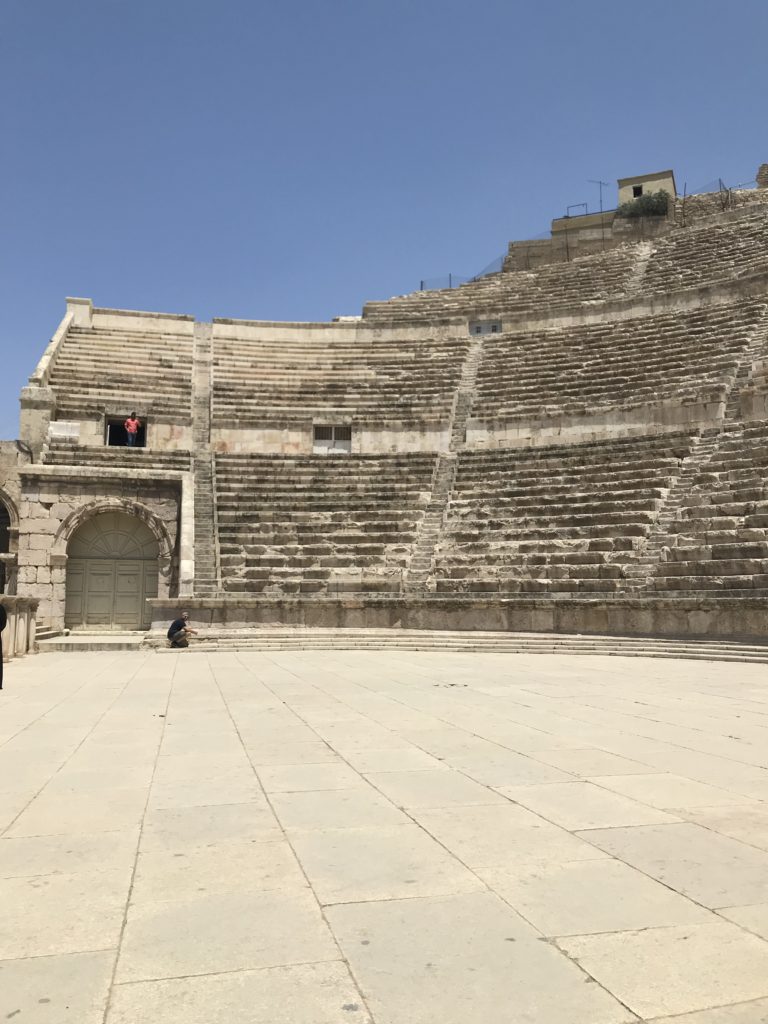
From where I am to where Rorie is crouching all the way across the Amphitheater, we could whisper and hear each other because of the crazy acoustics!
Later that evening, we did the latest version of our travel tradition – cooking classes – at a spot called Beit Sitti (meaning, “My Grandmother’s Kitchen”) in Amman. While it was excellent that the class took place on the stunning terrace of an apartment, the really cool part is that the whole angle of this class is that you cook with real Jordanian grandmothers, rather than chefs. Thus, we were able to learn how to make pita from scratch (I did all the hard work and they turned out glorious), a surprisingly delicious cucumber/onion/tomato salad with pomegranate molasses (!), mutabal (an eggplant dip with yogurt), maqluba (a chicken dish with rice) and a super moist coconut cake. Aside from it being our first real foray into middle eastern food, this class was quite notable for the fact that we sincerely loved every single item we cooked, which isn’t always the case with these things. It was also fun to cook with the grandmother, who spoke basically no English, measured none of the ingredients, and would adorably try to be patient about having us help before just taking over herself when we weren’t doing it fast/well enough (e.g., me mixing the dough for the pita). It ended up being an excellent meal and a fun evening!
While in Amman, we also spent one day taking a little road trip to the north to experience a couple other sights in the region. As this was our first time properly driving in Jordan, we were introduced to the idiosyncrasies of this tiny country. While it is easy to drive here (the roads are pretty straightforward, Google Maps works most of the time, and traffic isn’t too congested), it is also maddeningly frustrating in some respects. My first pet peeve about driving here is the “camouflaged” speed bumps that dot all the roads in the country, including the freeways where the speed limit is 110 km/hr. They’re camouflaged because they’re the same color as the rest of the concrete and only occasionally are near signs warning about their existence, so all too often we’ll be speeding down a straightaway and either (1) Jess will yell “bump!”, (2) I’ll notice independently and hastily brake in advance or (3) we’ll take bone-jarring rides over the bumps at full speed. Not good. [Editor’s note: I’ve embraced my role as Chief Bump-Noticer, but when I shirk my duties our poor little car feels like it’s going to fall apart. My favorite part is that occasionally the force of the bump will cause the windshield wipers to turn on, which I like to think is the car pitifully groaning “please don’t….” to Rorie.] The other issue is that Jordan doesn’t believe in driving lanes…anywhere. There are no lanes painted on city roads or freeways, so people just swerve all over the road with no structure. It’s maddening. I’ve stopped using my turn signal here – which allows me to blend in with other Jordanians – in strict defiance of these moronic ways.

A horse and a sheep in the back of a pickup truck. Not a speed bump, but a fun Jordanian traffic scene nonetheless.
Anyway, back to our road trip. Our first stop, which was on the way to the Syrian border, was a set of Roman ruins called Jerash. This was one of the largest cities in the Roman Empire and is remarkably well preserved today, in part, due to the super dry conditions of the north, which kept the ruins from deteriorating too much over time (it helps that they were functionally “lost” for a long time during the Ottoman Empire). The place was mostly empty when we arrived in the morning (thanks, Ramadan!), so we moseyed around at a leisurely pace seeing the jousting arena, plaza, ornate gate into town, the main road through town and, most awesomely, the well-preserved theater. The theater was cool because, well, we seem to have a thing for these types of structures (they’re never not impressive), but also because there were a couple of Bedouins in full regalia playing bagpipes in the theater! Apparently they learned how to play them through a joint initiative with Scotland, so we were treated to the cognitive dissonance of hearing Scottish music played by Arabic Bedouins in a Roman amphitheater. Travelling is the best. [Editor’s note: I guess they’re demonstrating the acoustics of the theater, which are admittedly great. Why bagpipes are the instrument of choice, I certainly don’t know, but I’m not complaining!]
After we finished seeing Jerash (narrowly escaping heat stroke), we then made our way to the nearby Ajloun Castle. This is a cool/notable sight because it is a castle from the Crusades that was built strictly for defense purposes and which was never captured or defeated in battle, which means it was never destroyed and is in pretty excellent condition. Because we had the site to ourselves again (this will be a recurring theme in Jordan), we wandered through and saw all the different defensive measures that they installed in the castle for defeating attacks. We also learned that the word “castle” in Jordan is functionally synonymous with “awesome views”, since every castle in this country was built on a large hill with sweeping views in all directions for defense purposes. This means that in addition to seeing a super cool looking castle, we also got wonderful vistas of the surrounding valley and countryside. A win by all accounts! [Editor’s note: Agreed in full on the hills and views! It’s also cool that while we’ve seen tons of temples of various sorts on our travels until now, we really haven’t seen any true castles or truly ancient ruins besides Angkor Wat. It’s really fascinating to see such classic Roman architecture in Jordan, and to learn about the millennia of history that each site contains. I really do feel a sense of how truly old everything is here in a way that I didn’t necessarily get in some of the other spots we’ve seen.]
Next, we’ll continue our Jordanian travels with a few stops further south as we leave Amman and head away from the big cities into the desert!
